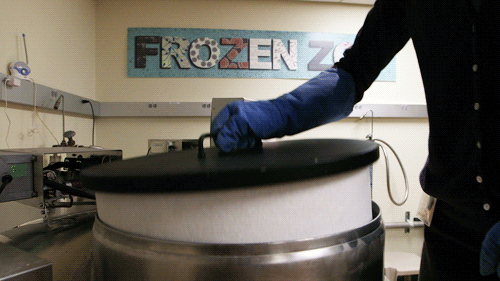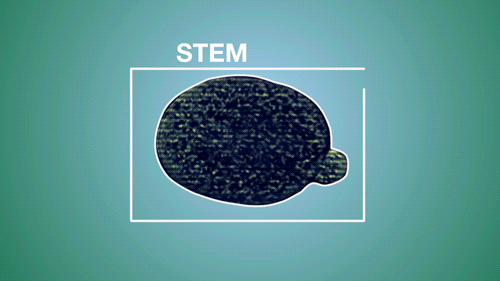Need to Know: The A to Z of Frozen Zoos
Update: A northern white rhino has died at the San Diego Zoo Safari Park. There are now only five members of the subspecies left on earth. With the population teetering on the brink of extinction, innovative techniques like artificial insemination and captive breeding programs may be the northern white rhino's only hope.
On “TechKnow,” Phil Torres traveled to the San Diego Zoo Safari Park to get a closer look at a different kind of zoo—a collection of cell cultures stored in giant freezers. Known as the “Frozen Zoo,” this conservation project hopes to preserve thousands of endangered species for research and to potentially engineer future generations.
It’s a complicated process, so we’ve broken down the basic terminology:
FROZEN ZOO
The Frozen Zoo at the San Diego Zoo Safari Park is run by the park’s Institute for Conservation Research. Here, scientists and researchers store and catalog cells from thousands of species—all frozen in liquid nitrogen for future research and propagation.

DNA and tissue samples collected from biopsies, as well as reproductive material like sperm and egg samples, are frozen to a low temperature very rapidly, keeping them in a state of suspended animation. These cells can currently be used to conduct vital research but the potential for their future use has scientists and conservationists even more excited.
“The possibility to save cells allowed us to undertake research right from the beginning that was relevant to reproducing endangered species,” explains Dr. Oliver Ryder, director of genetics for the Institute for Conservation Research. “Each cell of an individual is capable of producing the entire individual.”
As advances in stem cell research continue, the hope is that the frozen cells will be used to preserve future generations of animals that are currently facing extinction, or even bring extinct species back from the dead.
Dr. Oliver Ryder, Director of Genetics
San Diego Zoo Institute for Conservation Research
GENETIC RESCUE
Genetic rescue, the concept of restoring an endangered species to full genetic health, is one of Ryder’s key mission at the Frozen Zoo. He hopes that conservation efforts will be enough to save one of the planet’s most severely endangered animals, the northern white rhino.
Because of poaching, Ryder says, "There are, at the most, four [remaining white rhinos with the ability to reproduce] and those are all very highly related. Inbred populations cannot survive as well as ones that have higher genetic diversity. That's where the notion of genetic rescue can come in."
Though genetic rescue, northern white rhino cells stored at the Frozen Zoo could be used to create healthy future generations. Advances in stem cell research have yielded positive results in mice populations, allowing scientists to create individual egg and sperm cells from stem cells taken from the mice.
If the process were successful with the northern white rhino cells, the resulting embryo could be implanted into a southern white rhino surrogate, allowing for a natural birth of a new northern white rhino. “We have inherited Earth from our ancestors,” Ryder says. “It’s our responsibility to pass it on to our descendents.”

The northern white rhino is perhaps the conservation effort closest to Ryder’s heart. “They are amazing. As big as they are, I think they're more like ballerinas than anything else. They are exquisite products of nature.”
DE-EXTINCTION & GENETIC DECAY
“Jurassic Park” may have introduced the concept of “de-extinction,” the revival of an extinct species, to the American viewing public, but the controversial science has very real applications. In Dr. Beth Shapiro’s paleo-genetic lab at the University of California at Santa Cruz, evolutionary genetics are studied using ancient DNA collected from preserved biological remains.
While the rate of DNA decay makes complete regenerations of long-extinct species like woolly mammoths or dinosaurs an impossibility, Dr. Shapiro acknowledges that the creation and breeding of genetically similar creatures is not out of the question.
“This is one of the reasons that people interested in de-extinction of the mammoth, for example, use recently developed genome editing techniques to make specific changes in the genomes of an animal that’s still alive to make it look more like the genome of the animal that you’re trying to de-extinct,” she says.
GENOME EDITING
By splicing ancient characteristics into the DNA of a modern organism, genome editing could allow researchers to create species like those that populated the earth millions of years ago.
“What you would need to know are the places in the genome—say you were using an elephant, for example—the places in the elephant genome that differed from the mammoth genome,” explains Shapiro. “Then, you would be able to have an elephant that has some of the characteristics of a mammoth. For example, tolerance to cold or longer hair.”
Scientists are already able to edit a genome, and Shapiro says that the ability to make multiple changes at once is “being developed as we speak.” But as the ability to bring extinct and near-extinct species back to life becomes more realistic, the ethical questions surrounding the process grow more numerous.
“If we have solved the problem that caused the extinction in the first place, then and only then can we begin to think about what the other consequences of bringing that species back would be,” says Shapiro.
Learn more about the Frozen Zoo and other genetic conservation efforts on Saturday's "TechKnow," 7:30ET/4:30PT.
Error
Sorry, your comment was not saved due to a technical problem. Please try again later or using a different browser.